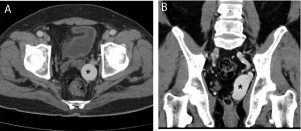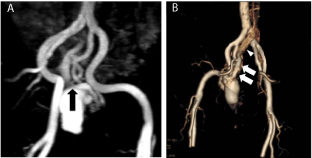Clinical Image
Time-Resolved Contrast Enhanced MR Angiography of Deep Pelvic Arterio-Venous Malformation
Uei Pua*
Department of Diagnostic Radiology, Tan Tock Seng Hospital, Singapore
*Corresponding author: Uei Pua, Department of Diagnostic Radiology, Tan Tock Seng Hospital, 11 JalanTan, TockSeng, 308433, Singapore
Published: 23 Jul, 2016
Cite this article as: Uei Pua. Time-Resolved Contrast Enhanced MR Angiography of Deep Pelvic Arterio-Venous Malformation. Clin Surg. 2016; 1: 1073.
Clinical Image
The diagnosis of Arterio-Venous Malformation (AVM) hinges on demonstration of arterial
feeders, nidus and early draining vein. Non-invasive imaging diagnosis however can be challenging
at times due to the location, complex morphology and variable flow rate of AVMs.
A 65 year old man recently diagnosed with descending colonic carcinoma underwent a staging
CT scan prior to surgery. Besides liver metastases, CT revealed a vascular lesion measuring 5.3 x 3.5
cm in the region of the left obturator canal (Figure 1A and B). Differential diagnosis included that
of a internal iliac branch aneurysm or a nidus of deep pelvic AVM.
He underwent time-resolved contrast enhanced MR angiography (Time-Resolved Imaging
of Contrast Kinetics (TRICKS), Siemens Healthcare, Erlangen, Germany). On time-resolved MR,
arterial supply from the left obturator artery was demonstrated with early arterial enhancement of
the lesion (nidus) (Movie 1, 3 seconds) and (Figure 2A). This was followed by early enhancement
of the left iliac vein (Movie 1, 6 seconds) due to early venous drainage through the nidus which
persisted on delayed imaging (Movie 1, 20 seconds) and (Figure 2B). The early venous drainage
was diagnosed in comparison to the lack of enhancement of the contralateral right iliac vein within
the imaged time frame. Review of the multiplanar images confirmed the left obturator arterial
supply to the nidus (Figure 2A) and direct drainage in to the anterior
division of the left iliac vein through small draining veins (Figure 2B),
confirming the diagnosis of an deep pelvic AVM.
The usefulness of time-resolved MR in the diagnosis of AVM
hinges on its ability to provide temporal flow information similar
to that of catheter angiography, in addition to multi-planar
reconstruction and various image manipulation for problem-solving
(Figure 2A and B), averting the need for invasive catheterization
and ionizing radiation. It is a robust technique has been utilized for
assessment of AVM in various body regions with complex vascular
anatomy [1,2].
Figure 1
Figure 1
A: axial (arrow) and B: coronal CT showing a vascular lesion (“*) in the region of the left obturator canal.
Figure 2
Figure 2
A: Right anterior oblique maximum intensity image (MIP) B: left posterior oblique view of the volume rendered image of the MR dataset showing arterial supply from the left obturator artery (A, white arrow) and the
early draining veins from the nidus into the anterior division of the left iliac vein (B, white arrows) and into left
common iliac vein (B, arrowhead).
Movie 1
Movie 1
Time-resolved contrast MR angiogram of the pelvic AVM. Note the
arterial supply from the left obturator artery (3 seconds, reference Figure 2A)
and early and persistent enhancement of the nidus (from 3 seconds). Early
enhancement of the left iliac vein (from 6 seconds and “arrow”) compared to
non-enhancement of the right iliac vein throughout the imaged sequence is
consistent with an early draining vein. The findings supported the diagnosis
of an arterio-venous malformation.
References
- Razek AA, Gaballa G, Megahed AS, Elmogy E. Time resolved imaging of contrast kinetics (TRICKS) MR angiography of arteriovenous malformations of head and neck. Eur J Radiol. 2013; 82: 1885-1891.
- Mostardi PM, Young PM, McKusick MA, Riederer SJ. High temporal and spatial resolution imaging of peripheral vascular malformations. J MagnReson Imaging. 2012; 36: 933-942.


